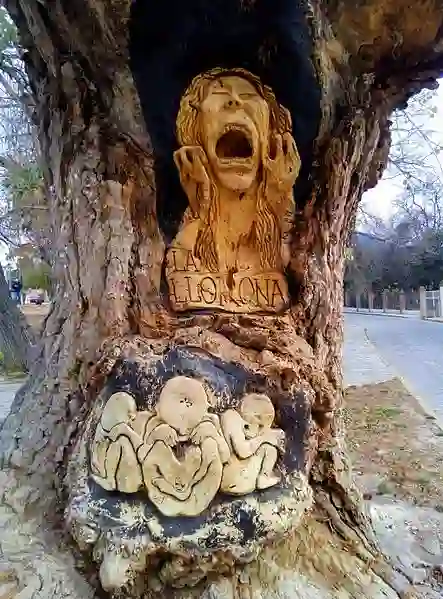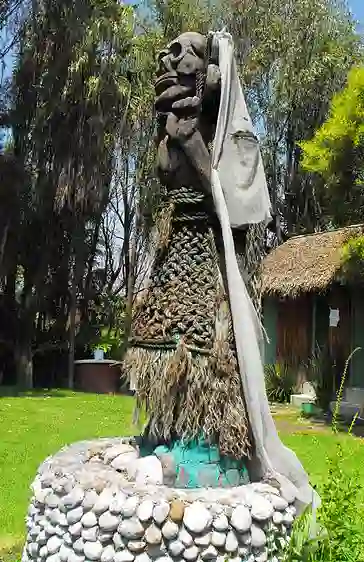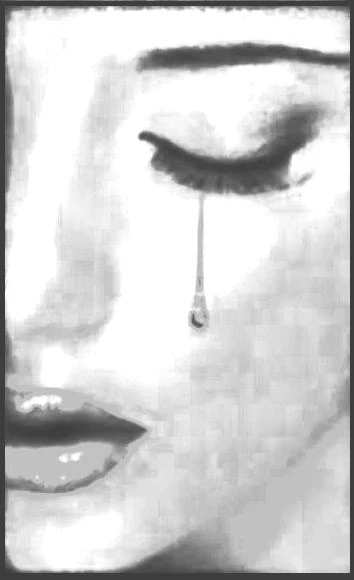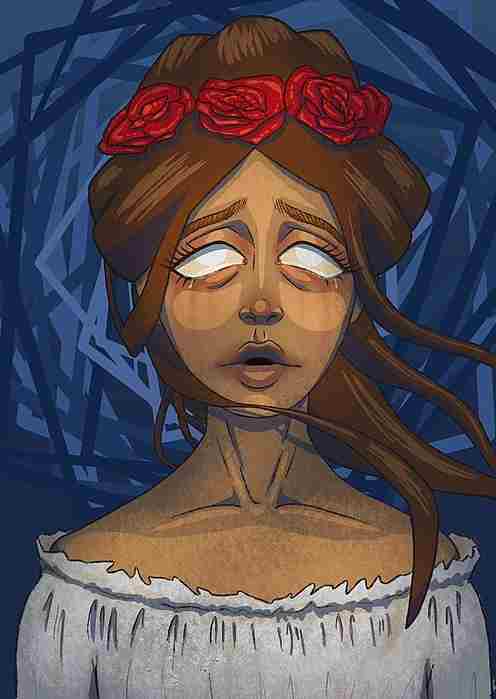La Llorona, The Legend of the Weeping Women
“La Llorona,” or “The Weeping Woman,” is a Hispanic American legendary vengeful ghost that is claimed to haunt waterfront locations mourning her drowned children.
Nobody exactly knows when the legend of La Llorona began or where it came from. Though the stories differ, the unifying thread is that she is the ghost of a drowned mother who spends eternity searching for her children in rivers and lakes.
La Llorona is frequently linked to children. In various myths, she is supposed to grieve for her own lost or dead children; in many of these stories, she killed her own children when she was alive and is fated to be a roaming ghost due to her deeds.

Who is La Llorona
La Llorona is a mythological character who has taken on numerous shapes and forms. She is frequently described as a banshee-type: an apparition of a woman clads in white, commonly found by lakes or rivers, occasionally at crossroads, who screams into the night for her lost children, whom she has slaughtered.
Her crime is frequently committed in a fit of craziness after she learns of an unfaithful lover or spouse who abandons her to marry a woman of better social standing.
She killed herself after realizing what she had done. She is frequently characterized as a lost spirit doomed to wander the planet indefinitely. Some regard her as a bogeywoman who parents utilize to terrify their children into good behavior.

The Origin of La Llorona
Early colonial texts show that the myth originated in the central highlands and pre-Hispanic. On the other hand, La Llorona is most closely identified with the colonial era and the interplay between Spanish conquistadors and indigenous women.
The most popular version is that La Llorona was an Indigenous woman who murdered her own children, whom she bore from a wealthy Spaniard after he abandoned her.
The wicked attributes of La Llorona, such as infanticide and murdering one’s blood, are thought to be linked to the story of Doa Marina, also known as La Malinche or Maltinzin in her original name. The legend of La Llorona is well known in Mexico and the Southwest United States today.
The first mention of La Llorona dates back to 1550 in Mexico City. However, there are ideas that her story is linked to specific Aztec mythology creation legends. “The Hungry Woman” features a weeping woman who is always pleading for food, similar to La Llorona’s distinctive midnight howling for her children.

La Llorona’s motherly aspect has been linked to Chihuacoatl, an Aztec goddess of motherhood. Her desire for children is similar to Coatlicue, also known as “Our Lady Mother” or Tonantsi, who is comparable to the Virgen de Guadalupe, another prominent mother figure in Mexican culture, a monster that devours filth or sin.
According to another legend, a vengeful mother who murdered her children can be traced all the way back to Greek mythology, who murdered her sons after being deceived by her husband, Jason. The haunting wails of a woman warning of imminent doom are likewise reminiscent of the Irish banshees.
According to the most recent version of La Llorona’s beginnings, she was born to a peasant family in a little village. Her stunning beauty drew the attention of rich and poor men in the neighborhood.
She was believed to spend her days in her lowly peasant surroundings, but on the nights, she would wear her best white dress and dazzle the men who admired her at the local fandangos.
The young men were eagerly waiting for her, and she relished the attention. On the other hand, La Llorona had two tiny sons that made it difficult for her to spend her evenings out, and she frequently left them alone while she partied with the gentlemen.

The two tiny boys were discovered drowned in the river one day. Some believe they drowned due to her carelessness, while others believe they died at her hands.
According to another legend, La Llorona was a loving woman who married a wealthy man who lavished her with gifts and care. He began to shift after she had two kids, returning to a life of womanizing and drunkenness, frequently abandoning her for months at a time.
He appeared to have lost interest in the lovely Maria, even discussing leaving her to marry a woman of his wealthy class. When he did return home, it was primarily to see his children, and the bereaved Maria began to detest the boys.
Maria was walking with her two children on a shady pathway by the river one evening when her husband arrived in a carriage accompanied by a beautiful lady. He came to a halt and spoke to his children, but he ignored Maria before driving the carriage without looking back.

Devastated, she drowned her children and committed suicide.
Her restless ghost began to manifest shortly after her death, strolling the banks of the Santa Fe River when darkness fell. Her crying and wailing became a curse of the night, and people grew terrified to walk out after dark.
According to another version of the story, Maria married in a spectacular stone cathedral in Mexico and had a wonderful wedding at no cost to her family.
The only requirement was that she give her firstborn son to the priesthood. Maria consented gladly at first, but after the birth of her first baby, she kept defaulting on her pledge, hoping the priest would forget.
She proceeded to have children while breaking her agreement with the church. Her house caught fire in what appears to be a sacred act of vengeance.
The fire destroyed her home and killed all of her children. Maria lived, but she was badly scarred, and her face began to resemble that of a horse. The people in the town started to refer to her as “The Donkey Lady.”
She spent the rest of her life mourning her loss amid the rivers and creeks. Maria’s spirit was tied to the rivers she wandered in life after her death.
Witnesses have seen her, severely scarred and horse-like, wading through the river, yelling “Mi Hijo! Mi Hijo!” as she seeks her dead children. Locals advise against attempting to save her; those who have tried have all mysteriously drowned.
She was believed to have been seen floating on the current or drifting between the trees along the shoreline in her long white gown spread out on the waves. On many dark nights, people would spot her going along the riverbed, wailing for her children.
As a result, they startered referring her as La Llorona, the weeping woman, rather than Maria. Children are told not to venture out in the dark because La Llorona may kidnap them and hurl them into the flowing rivers.
The dead children and a sobbing woman, human or ghost, are constants throughout the legend. La Llorona is frequently seen dressed in white and wailing for her children near running water.
According to certain legends, the ghost of La Llorona is feared. She is supposed to be vindictive, seizing other people’s children to drown instead of her own.
According to other stories, she is a warning, and people who hear her cries will soon die. She is sometimes viewed as a punitive figure and appears to children who are disrespectful to their parents.

How Does La Llorona Looks Like?
She is supposed to have a blank face with no features, lacking a mouth, nose, and eyes; a terrifying image for people who hear her weeping and have no idea where the sound is coming from.
According to some eyewitnesses, she is a tall, slim soul who is blessed with natural beauty and long flowing black hair. She is dressed in a white gown.
When someone approaches her, she lets out a piercing and otherworldly screech. As if that weren’t enough, meeting La Llorona brings a curse upon the witness.
Those who glimpse La Llorona suffer disaster immediately afterward. They may suffer the loss of a family member or a loved one. Some have become unwell, while others have been hurt in strange accidents.

Why do They Call Her La Llorona?
La Llorona represents weeping ladies. Her wails are so desperate and piercing that they are mistaken for the pleas of a lost or endangered child, leading unsuspecting victims into her waiting arms.
But she is frequently seen at night, clad all in white with long black hair flowing over her face, standing at the edge of the woodland.
She beckons to lone children, offering false promises and leading them past the tree line and toward the water—replaying her sins forever.
What are the Abilities La Llorona Have?
According to legend, despite La Llorona being most known for destruction and death, she also has the potential to generate life.

Few Popular Sightings of La Llorona
In 1986, Juana Léija, a Mexican woman, attempted to kill her seven children by dumping them into the Buffalo Bayou in Houston, Texas. She was a victim of marital violence and appeared to be trying to stop her, and her children’s suffering, two of whom perished. During an interview, Léija declared herself to be La Llorona.
This folk tale has been creatively depicted in various ways, including film, animation, painting, poetry, theater, and literature directed at adults and children. The legend is firmly ingrained in Mexican culture and among the United States Chicano Mexican minority.
When he was a child, Patricio Lugan and his family first spotted her in a creek between Mora and Guadalupita, New Mexico. While the family conversed outside, they noticed a tall, slender woman walking along the creek.
She suddenly appeared to float above the water, began climbing the hill, and vanished. However, she reappeared moments later, considerably closer to them, and disappeared. The family searched for tracks but found none, making them doubtless that the woman they had seen was La Llorona.
She has been spotted along various rivers throughout the Southwest, and the legend has been ingrained in Hispanic culture worldwide. According to legend, people who do not treat their families well will encounter her, and she will give them a lesson.
Another story involves a man named Epifanio Garcia, who was an outspoken young man who frequently battled with his mother and father. Epifanio and his brothers Carlos and Augustine decided to abandon their ranch in Ojo de La Vaca and travel to the Villa Real de Santa Fe after a passionate fight.

However, they were stopped along the way by a tall woman wearing a black tapelo and a black net over her face.
The spirit appeared on the seat between two youngsters traveling in the wagon’s front. She sat silently until Epifanio turned the horses around and returned home, at which point she added, “I will see you again someday when you quarrel with your mother.”
The towering weeping spirit has been observed several times in the Public Employees Retirement Association Building in Santa Fe, New Mexico, which was pitched on a previously old Spanish Indian graveyard and is near the Santa Fe River.
Many employees have reported hearing cries echoing through the halls and feeling unknown hands pushing them on the stairwells.
How Can You Defeat La Llorona
Some believe that if you have a close link with your wife and children, La Llorona cannot hurt you; if she approaches you or screams at you, she cannot harm or curse you, and she will quickly vanish.
As per different legends, you cannot overcome La Llorona. Trying to defeat La Llorona is a suicide mission. According to legend, anyone who approaches the ghost of La Llorona and hears her scream will experience misfortune or death. It is also stated that running in the opposite direction of her shouting will help you avoid her scream.

Character Adaptation in the Modern Era
Naturally, the La Llorona story has been exploited and represented in popular culture and Mexican film throughout the twentieth and twenty-first centuries.
In the 1960s, Rene Cardona directed La Llorona, a Mexican film that narrates the experiences of a family haunted by the evil spirit of the weeping woman.
More recently, in 2013, the Universal Studios theme park in Orlando, Florida, featured La Llorona as one of several “scare zones” in the annual Halloween Horror evenings, including mazes, films, and unsettling entertainment focused on the Mexican legend.
Tourists entered an abandoned Mexican chapel and attended a burial for her victims, with creative park directors hoping to “transport guests into her enigmatic domain.” La Llorona is much more than a horror story; Maria’s inner suffering endows her character with a level of vulnerability rarely seen in terrifying folklore.
In the 2007 film J-ok’el, La Llorona is the main antagonist. She is presented as a more sympathetic figure in the 2011 Mexican animated film La Leyenda de la Llorona, whose children die in an accident rather than at the hands of their mother.
In the 2017 Pixar film Coco, Alanna Ubach sings “La Llorona,” a Mexican folk song popularized by Andres Henestrosa in 1941. Antonio Sol joins her as Ernesto de la Cruz’s singing voice.
For Warner Bros. Pictures, James Wan, Gary Dauberman, and Emilie Gladstone produced The Curse of La Llorona in July 2019. Michael Chaves directed the picture, which stars Linda Cardellini, Raymond Cruz, Patricia Velasquez, and Marisol Ramirez as La Llorona.
The Guatemalan film La Llorona, directed by Jayro Bustamante and starring Mara Mercedes Coroy, was screened in the 2019 Toronto International Film Festival.
Conclusion
Underneath the story is an ambiguous message that explains the legend’s endurance in popular culture; Maria’s destiny represents the unavoidably tragic outcome of shallow goals and an inflated sense of self.
Other writers have criticized the legend’s portrayal of masculinity, emphasizing female duty and male absence.
She drifts over and near bodies of water in her white funereal gown, weeping uncontrollably as she searches for her missing children. According to certain versions of the myth, she kidnaps or attacks children, while others claim she attacks unfaithful husbands. The directive stays the same when you hear La Llorona’s cries: don’t wait. Simply run as quickly as you can.
References
https://blogs.loc.gov/folklife/2021/10/la-llorona-an-introduction-to-the-weeping-woman/







